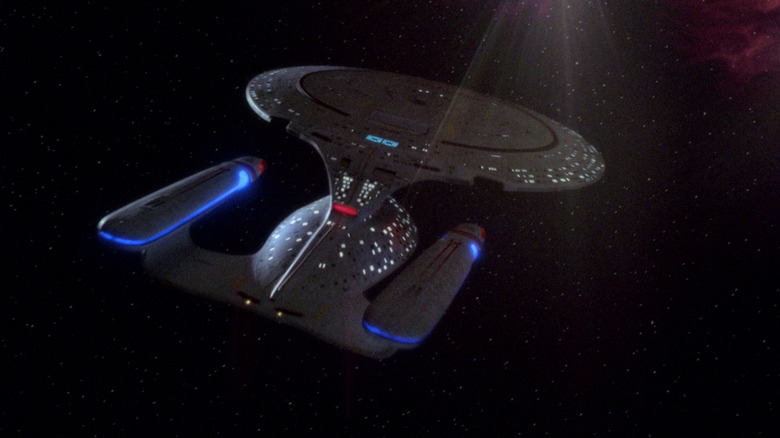The ultimate episode of “Star Trek: The Subsequent Era,” known as “All Good Issues…,” aired on Might 23, 1994, though many Trekkies weren’t solely heartbroken. Whereas viewers would now not be capable of see the weekly adventures of the Enterprise-D and its stalwart crew, all of them knew that the spinoff function movie, “Star Trek: Generations” was due in theaters in solely six months. Moreover, “Star Trek: Deep House 9” was already chugging alongside into its third season, and “Star Trek: Voyager” was actively creating. I inform ya, the Nineteen Nineties was a grand time to be a Trekkie.
In fact, on the time, many followers puzzled why “Subsequent Era” felt the necessity to cease after solely seven seasons. Scores had been excessive, and the present hadn’t waned in cultural recognition. The forged had even signed on to behave in an eighth season, steeled to resist one other yr in area. There was each purpose to imagine that “Subsequent Era” would proceed indefinitely, or at the least till audiences stopped paying consideration.
The actual fact of the matter was, although, that the collection was getting too costly to provide. The core seven forged members (Gates McFadden, Patrick Stewart, Michael Dorn, LeVar Burton, Marina Sirtis, Brent Spiner, and Jonathan Frakes) had been fetching larger and better salaries, and the present’s producers knew that they needed to hold pushing the bounds of TV particular results to maintain audiences engaged with a galaxy-spanning area opera. And there have been different, extra technical prices to think about; it appears that evidently Paramount was about to have a troublesome time promoting “Subsequent Era” to native TV stations.
This was all detailed in a July 1994 article within the New York Occasions. Not solely was the worth tag on “Subsequent Era” getting too excessive, however the present’s uncommon distribution mannequin was getting much less and fewer tenable. Somewhat than hold pushing into the frontier of unbalanced accounting sheets, the studio ended the collection whereas it was nonetheless using excessive.
Star Trek: The Subsequent Era was too costly and was about to get too troublesome to promote
For many of its historical past, “Star Trek” has engaged in uncommon distribution patterns. The unique collection was broadcast on NBC, however did not develop into a cultural phenomenon till it was offered into syndication; it was solely in reruns that the collection grew to become the phenomenon that it did. “Subsequent Era,” in the meantime, was offered on to native TV stations, somewhat than linking itself to a single community (Paramount did not attempt to launch its personal TV community in earnest till 1995). To be able to purchase “Subsequent Era,” an area station was required to rerun each single episode at the least seven occasions, which allowed for a glut of “Subsequent Era” reruns; there was a time when one might see each “Star Trek” and “Subsequent Era” every day.
In fact, with seven seasons and 278 episodes, promising to rerun every one seven occasions induced some concern. What station would need to commit to purchasing 1,946 hours of TV? Would viewers stay interested by seven full go-throughs of a single collection? It was a time dedication that Paramount knew it might have bother promoting. Additionally, spending developments in 1994 dictated that newer episodes fetch decrease costs than early ones, not larger. This meant Paramount would, total, earn much less promoting “Subsequent Era,” proper when it was costing an increasing number of to make (because of these rising salaries and SFX budgets).
Total, it simply wasn’t economically possible. In brief, “Subsequent Era” ended as a result of there was already an excessive amount of of it. It would not be till a lot later that “Star Trek’s” film and TV rights can be break up between two firms, complicating issues additional.
The forged did not know why Subsequent Era was being canceled
In keeping with a 1994 article in EW, the forged wasn’t advised any of the above info. They solely heard tales of their present’s excessive rankings and knew that they had been contracted for an eighth season. When Paramount mentioned they had been canceling the present, nobody was in a position to give the forged a stable purpose as to why. They definitely weren’t advised the labyrinthine particulars of native TV distribution contracts. A film, after all, had been deliberate, however actor Jonathan Frakes did not see any purpose why a film could not have been delayed a further yr. He expressed his frustration thus:
“I have never been given any purpose that holds water. […] Possibly [Paramount] thought they could not do the film and the TV present on the similar time-although I do not know why the film needed to be made this yr. A few of us saved hoping there can be an eleventh-hour reprieve, that Paramount would understand how a lot cash the present has made for them and alter their minds.”
In keeping with “Star Trek” govt producer Rick Berman, the choice to finish “Subsequent Era” after seven years was all Paramount’s doing. It was determined even earlier than “Star Trek: Voyager” was pitched. The writers, whereas maybe feeling slightly burnt out, had been nonetheless on board, and the forged all appeared to be sport (though Spiner was quoted within the EW article as being considerably dispassionate). However, like all issues, it got here all the way down to cash. The EW article additionally quoted Paramount govt Joel Berman (no relation), and he famous {that a} movie franchise can be extra worthwhile than a TV franchise.
In fact, the cancelation of “Subsequent Era” after seven years set the template. Each “Deep House 9” and “Voyager” lasted seven years, and 2001’s “Star Trek: Enterprise” would have adopted swimsuit if it hadn’t been canned after solely 4. And now, within the streaming period, companies should buy up entire reveals with out having to decide to seven reruns, altering the foundations solely. In fact, even with the brand new guidelines, “Star Trek” remained ubiquitous.



